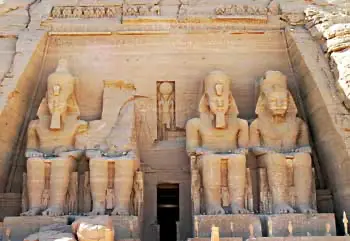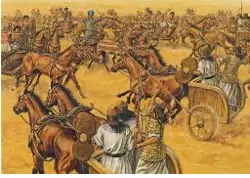Ramses II: Famed Pharaoh of Egypt
Ramses II was one of Ancient Egypt's most celebrated warriors and one of the civilization's most famous pharaohs. 
He was born about 1303 B.C. His father was the pharaoh Seti I, who set about turning his son into king material early on. By the time he was 10, young Ramses was a captain in the army; when he turned 14, he became Prince Regent. He followed his father on campaign and learned firsthand how to conduct a military campaign; he sat by his father's side at court and learned firsthand how to run a country. When Seti I died in 1279 B.C., Ramses was more than ready to take over. Almost right away, Ramses II embarked on a number of large building projects. He commissioned the construction of monuments, temples, and even new cities. He made his capital a city that he created, naming it Pi-Ramses. 
Among his creations was the Ramesseum, a large temple complex on the West Bank of the Nile near Thebes. A giant statue of the pharaoh dominates his mortuary temple there. Also very large are the statues of Ramses II at Abu Simbel, in southern Egypt; the four statues that depict the pharaoh stretch to 66 feet high. Fighting was a regular occurrence for most pharaohs, and Ramses' reign was no exception. He ordered and/or led several campaigns against neighboring civilizations, including the Libyans and Nubians. He beat back incursions from sea pirates early in his reign. At its height, the Egyptian army under Ramses II exceeded 100,000 men. 
Perhaps the most well-known of these was the Battle of Kadesh, in 1274 B.C. Fought between Egypt and an alliance of foes including the Hittites and the Mittani, this battle, sources say, was the largest chariot battle in history, with numbers of the horse-drawn battle vehicles exceeding 5,000; overall numbers for both sides have been estimated at 70,000. Tactically, the battle ended in a draw; that didn't stop Ramses from claiming victory. Further struggles against the Hittites occurred in the next several years; in 1258 B.C., Ramses and the Hittite king Hattusili III signed the Treaty of Kadesh, one of the world's first peace treaties. Helping relations between Egypt and the Hittites was the marriage of Ramses to the oldest daughter of the Hittite king. 
Ramses II, as was the custom, had several wives during his reign. The most famous of his wives was Nefertari (right), who was, by several accounts, beautiful and intelligent; her ability to read and write hieroglyphs demonstrated her advanced education. His reign was long; many sources say that he was on the throne for 66 years. He died in 1213 B.C., at age 90, having suffered from arthritis and hardening of the arteries and other health problems for several years. He was said to have been the father of more than 150 children, many of whom he outlived. One of his sons, Merneptah, succeeded him as king; the 13th son of Ramses II, Merneptah took the throne when he was 60. |
|
Social Studies for Kids
copyright 2002–2025
David White




